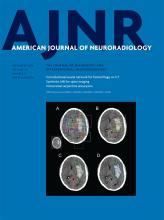Index by author
Collins, Scott
- You have accessPerspectivesScott CollinsAmerican Journal of Neuroradiology September 2018, 39 (9) 1583; DOI: https://doi.org/10.3174/ajnr.P0068
Costalat, V.
- InterventionalYou have accessAcutely Ruptured Intracranial Aneurysms Treated with Flow-Diverter Stents: A Systematic Review and Meta-AnalysisF. Cagnazzo, D.T. di Carlo, M. Cappucci, P.-H. Lefevre, V. Costalat and P. PerriniAmerican Journal of Neuroradiology September 2018, 39 (9) 1669-1675; DOI: https://doi.org/10.3174/ajnr.A5730
Cummings, D.D.
- PediatricsYou have accessTime Course of Cerebral Perfusion Changes in Children with Migraine with Aura Mimicking StrokeK.M. Cobb-Pitstick, N. Munjal, R. Safier, D.D. Cummings and G. ZuccoliAmerican Journal of Neuroradiology September 2018, 39 (9) 1751-1755; DOI: https://doi.org/10.3174/ajnr.A5693
Da Rocha, A.J.
- You have accessMR Imaging Features of Adult-Onset Neuronal Intranuclear Inclusion Disease May Be Indistinguishable from Fragile X–Associated Tremor/Ataxia SyndromeI.G. Padilha, R.H. Nunes, F.A. Scortegagna, J.L. Pedroso, V.H. Marussi, M.R. Rodrigues Gonçalves, O.G.P. Barsottini and A.J. da RochaAmerican Journal of Neuroradiology September 2018, 39 (9) E100-E101; DOI: https://doi.org/10.3174/ajnr.A5729
Das, S.
- EDITOR'S CHOICEAdult BrainOpen AccessQuantitative MRI of Perivascular Spaces at 3T for Early Diagnosis of Mild Cognitive ImpairmentM. Niazi, M. Karaman, S. Das, X.J. Zhou, P. Yushkevich and K. CaiAmerican Journal of Neuroradiology September 2018, 39 (9) 1622-1628; DOI: https://doi.org/10.3174/ajnr.A5734
The authors automated the identification of enlarged perivascular spaces in brain MR images using a custom quantitative program designed with Matlab. They quantified the densities of enlarged perivascular spaces for patients with mild cognitive impairment (n=14) and age-matched cognitively healthy controls (n=15) and compared them to determine whether the density of enlarged perivascular spaces can serve as an imaging surrogate for mild cognitive impairment diagnosis. The density of enlarged perivascular spaces was found to be significantly higher in those with mild cognitive impairment compared with age-matched healthy control subjects.
Delattre, B.M.A
- EDITOR'S CHOICESpineYou have accessFeasibility of a Synthetic MR Imaging Sequence for Spine ImagingM.I. Vargas, M. Drake-Pérez, B.M.A Delattre, J. Boto, K.-O. Lovblad and S. BoudabousAmerican Journal of Neuroradiology September 2018, 39 (9) 1756-1763; DOI: https://doi.org/10.3174/ajnr.A5728
Thirty-eight patients with clinical indications of infectious, degenerative, and neoplastic disease underwent an MR imaging of the spine. The SyntAc sequence, with an acquisition time of 5 minutes 40 seconds, was added to the usual imaging protocol consisting of conventional sagittal T1 TSE, T2 TSE, and STIR TSE. The image quality was rated as “good” for both synthetic and conventional images. Interreader agreement concerning lesion conspicuity was good with a Cohen kappa of 0.737. The authors conclude that the study shows that synthetic MR imaging is feasible in spine imaging and produces, in general, good image quality and diagnostic confidence.
Derdeyn, C.P.
- You have accessReply:P. Nagpal, B.A. Policeni, M. Kwofie, G. Bathla, C.P. Derdeyn and D. SkeeteAmerican Journal of Neuroradiology September 2018, 39 (9) E104; DOI: https://doi.org/10.3174/ajnr.A5758
Deveber, G.
- FELLOWS' JOURNAL CLUBFunctionalYou have accessBreath-Hold Blood Oxygen Level–Dependent MRI: A Tool for the Assessment of Cerebrovascular Reserve in Children with Moyamoya DiseaseN. Dlamini, P. Shah-Basak, J. Leung, F. Kirkham, M. Shroff, A. Kassner, A. Robertson, P. Dirks, R. Westmacott, G. deVeber and W. LoganAmerican Journal of Neuroradiology September 2018, 39 (9) 1717-1723; DOI: https://doi.org/10.3174/ajnr.A5739
Twenty children (30 imaging sessions, 60 MR scans) with Moyamoya disease underwent dual breath-hold hypercapnic challenge blood oxygen level–dependent MR imaging of cerebrovascular reactivity studies in the same MR imaging session. Within-day, within-subject repeatability of cerebrovascular reactivity estimates, derived from the blood oxygen level–dependent signal, was computed. Breath-hold hypercapnic challenge blood oxygen level–dependent MR imaging is a repeatable technique for the assessment of cerebrovascular reactivity in children with Moyamoya disease and is reliably interpretable for use in clinical practice.
Di Carlo, D.T.
- InterventionalYou have accessAcutely Ruptured Intracranial Aneurysms Treated with Flow-Diverter Stents: A Systematic Review and Meta-AnalysisF. Cagnazzo, D.T. di Carlo, M. Cappucci, P.-H. Lefevre, V. Costalat and P. PerriniAmerican Journal of Neuroradiology September 2018, 39 (9) 1669-1675; DOI: https://doi.org/10.3174/ajnr.A5730
Diehn, F.E.
- SpineOpen AccessReview of the Imaging Features of Benign Osteoporotic and Malignant Vertebral Compression FracturesJ.T. Mauch, C.M. Carr, H. Cloft and F.E. DiehnAmerican Journal of Neuroradiology September 2018, 39 (9) 1584-1592; DOI: https://doi.org/10.3174/ajnr.A5528








